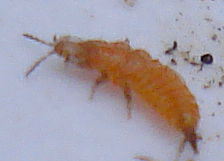 "One Yellow Thrips Nymph (Thysanoptera)" image by Mick E. Talbot - Very, very busy..!! You have to love the photographer's "Flickr" name.
Different types of thrips have very different appetites. My article explains more about them.
Promoting my Article about Thrips
Writing Tip Regarding Thrips
This new writing tip actually answers "Why bother promoting your online article in other blogs"?
There are two reasons for cross-promoting your articles.
First, the search engines notices that your article has inbound links. This gives your article a slightly higher ranking, compared to web pages that no-one else has referenced. Admittedly, it may not count for much if your blogs don't rank highly themselves; but it should not hurt too much.
Second, you might reach new readers for the article because they follow your blog. Possiby they found your blog when searching for the topic, instead of finding the main article.
Those are the effects I'm hoping for by publicizing my article about the thrips.
By the way, you writers may have noticed that all the article titles imply the ambiguity about thrips, because some are beneficial, others are neutral in certain settings, but we tend to focus on the thrips as insect pests.
Once again I will use this blog to publish some of my own creations: images to be added to an upcoming article in Decoded Science. [ Edited June 13, 2011: "The Proof and Practice of Thales' Theorem for Circled Triangles" was published today. It explains how to prove the theorem that angle(AOC) in the first diagram is always 90 degrees, no matter where point C is placed on the circumference. Well, anywhere but points A or B, obviously. As always, I also promoted the Dec.Sci. article in my main site, in the blog entry " Decoded Science Reveals How to Prove Thales’ Theorem". ] 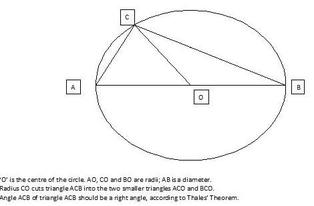 "Thales Triangle with Notes" by Mike DeHaan This is the basic diagram for Thales' Theorem.
It is so clear, simple and obvious, it is a wonder there is any need for an article at all.
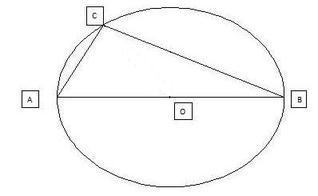 "Triangle in a Circle" by Mike DeHaan Surprisingly, this is the initial diagram for the article. Clearly the previous diagram is built from it.
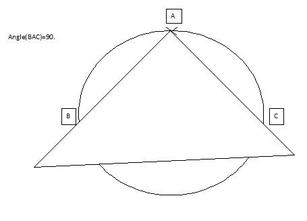 "Starting to Seek the Centre of a Circle" by Mike DeHaan Completely different circles and triangles are used for the second pair of images in my article about Thales' Theorem.
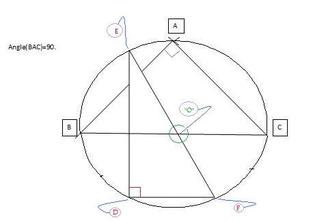 "Having Found the Centre of a Circle" by Mike DeHaan Finishing the group of diagrams is the completion of the previous image. Hopefully this will be crystal clear to the readers of Decoded Science.
Today two completely different articles were published on two completely different subjects at two completely different sites.
Numerologists need not apply; there is nothing special about "two, two and one" as far as I know.
Super-Powered Reindeer
 "Image of Svalbard Reindeer" by Billy Lindblom Submitted yesterday, "The Reindeer Superpower: Ultraviolet Vision" explores the advantages an arctic herbivore has when it can see ultraviolet light.
 "One Reindeer in Kebnekaise Valley, Lappland, Sweden" by Alexandre Buisse (Nattfodd)
There are more great images in the story, but as a writer, I thought my words were pretty good, too.
Warm Up Before Exercising
I also wrote " Warming Up To Exercise" today. Cold muscles should not be exercised, but only exercise warms up the muscles. This article explains the " warm up paradox" and presents five tips to safely warm up before exercise. Publicity via DeHaan Services
 "DeHaan Services" business card Of course, I also wrote about these articles in my DeHaan Services blog post, " Reindeer and Warm-Up Exercises in Separate Articles". The "Exercise" article is especially appropriate in this site, which hosts my fitness and weight control clinic. Come to think of it, I publicized previous articles there too. "The Fibonacci Sequence at Decoded Science" and "Three Articles about Curcumin and Turmeric" were self-publicizing articles that I posted in DeHaan Services blogs also.The writing tip is: pursue shameless self-promotion through publicizing your own articles.
Today I submitted my first article to the new web site being developed by Victoria Nicks. " Decoded Science" is "...the source for new and exciting developments in the scientific community". 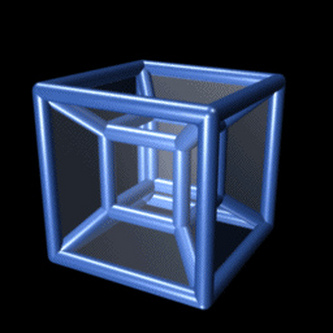 "Eight Cell Tesseract Image" by mmhydrazinen04 My first article is "The Tesseract: Folding and Unfolding a Simple 4D Hypercube". In math, every tesseract is a hypercube but not all hypercubes are tesseracts. My article gives a simple introduction, with some fascinating visuals. By the way, Decoding Science uses a Wordpress theme.
I kicked off a planned set of articles about cinnamon with " Cinnamon: Asia's Popular Spice Tree" at Environmental Graffiti. 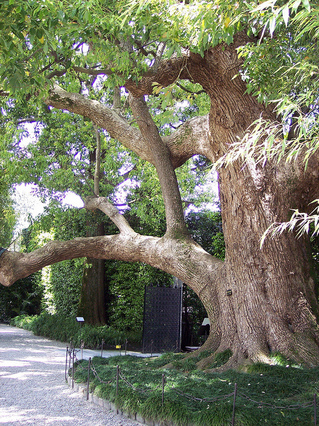 "Cinnamon Tree at Lake Maggiore" by rosemarydukelow
Naturally you know and love the spice, and you might have been told that cinnamon comes from a tree.
Did you know where cinnamon trees grow and are cultivated? Or what part of the tree gives us powdered cinnamon or cinnamon sticks? That's what my first article reveals.
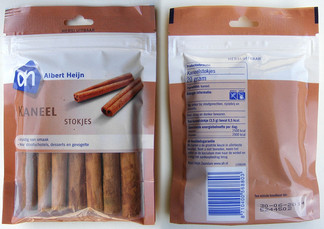 "Cinnamon Sticks and Cinnamon Powder Spice" by FotoosVanRobin Trust Suite 101 for Natural Health via CinnamonOn May 13 I published the " Important Health Benefits of Cinnamon in the Human Diet" on Suite 101. This article's focus is on eating cinnamon as a spice. People with type 2 diabetes, and those trying to avoid a heart attack, are also encouraged to read and decide whether to increase their consumption of cinnamon powder. Let me thank Natural Health Science News for listing me in their directory and sending at least one reader to my article on May 17. Adding Spice to a Squidoo LensWhile I was at it, I updated the DeHaan Lens for Weight Control through Diet with some comments and recommendations on using cinnamon. It also points to some products available through Amazon. As always with articles and advice oriented to health, it is important to check with one's physician before committing to a radical change.
I began writing some Squidoo Lenses several months ago. (A "Lens" is Squidoo's name for "article"; it is supposed to be "focussed" on a topic). Perhaps the most important feature of Squidoo is that it blatantly includes author-generated advertising...in addition to whatever advertising the Squidoo site adds to each Lens. Although it has a report page listing each of my Lenses, with its rank, number of visits, and earnings, I have never seen any earnings attached to a Lens. I believe this means that no-one has clicked through my self-authored Amazon advertising to buy goods. Imagine my surprise when I noticed that I had earned 52 cents. Whoo-hoo! But it was completely unclear how this had occurred.This month, the number more than doubled to $1.08. They also provide a breakdown of how the money was earned. In my case, half comes from the "ad pool", and most of the remainder from the "reserve hopper". Infolinks and Chitika trail the leaders. So it seems that Squidoo does pay, even very minor authors, out of the advertising pool.My second point of celebration: This week I had a record 19 visitors to the DeHaan Lens for Coat Racks. Come on over and check them out! 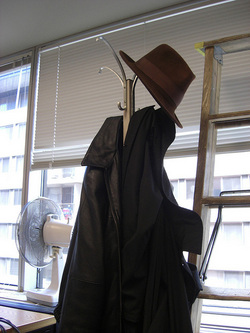 Image of a Coat Rack by jon_a_ross
In Feb. of 2011, H. Gardener presented a study linking drinking diet soda pop daily to a higher risk of stroke. Although the report was criticized and became the centre of a storm of controversy, it did show a meaningful statistical relationship. Personal health is a very important topic, especially for Baby Boomers who are trying to stave off aging and its related diseases. Stroke, a "cardiovascular accident", interrupts the supply of blood to the brain. Long-term damage can be significant: partial paralysis, blindness and slurred speech all come to mind. Meanwhile, many people are overweight and need to reduce their intake of calories. Diet soda seems like a way to keep the taste but lose the sugary calories. My article, " Does Diet Soda Increase the Risk of Stroke? Yes, No and Maybe", asks whether diet soda is bad? Should people stop drinking diet pop? What are healthful ways to reduce the risk of stroke? 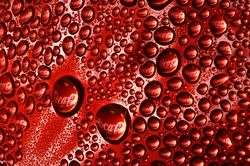 'Image of Bubbles of Diet Soda' by sippakorn yamkasikorn.
My article, " How Packaging Made from Mushrooms Could Benefit the Environment", was published today on Environmental Graffiti. This new method grows the mushroom's mycelium in the desired shape...well, you will just have to read my original article to appreciate the cleverness. Just a note about writing this article: it took longer than I expected, even though there were plenty of leads and enough "commercial reuse" images readily available.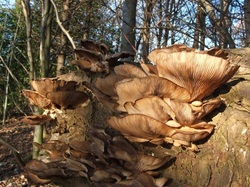 Image of Branching Oyster Mushroom by Lairich Rig
My latest article at Environmental Graffiti is titled like an action thriller. " Tamarisk Leaf Beetle Battles Salt Cedars in the American West" explains why the United States is inviting a Eurasian beetle to fight the invasive tamarisk tree, otherwise known as the salt cedar. Let's note in passing that the tree itself was invited to North America in the 1800s. Writing this article was fairly straightforward. There were quite a few images of the tamarisk beetle, and of the lovely flowers of the salt cedar. It was hard to find a good picture of the whole tree, however; that may be my biggest disappointment in the article. 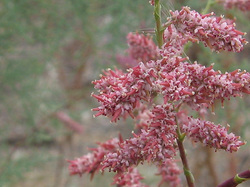 Pink Tamarisk Flower' by miheco
In a shortened work day, I began a very specific quest for perfection...or, at least, for improvement.Suite 101 had been adversely affected by Google's Panda update in late February. They just published new guidelines for articles.
Perhaps thanks in part to an opinion I expressed, any article may have no more than three explicit links to other Suite 101 articles. The draft suggestion had whittled this down to two links. My argument was that even a chain of articles needs a "first", "previous" and "next" pointer. Otherwise a reader has to work too hard to find the start.
My actual concern was that I had written a mesh of articles about Mennonites. One reason is that Suite 101 has a category for Mennonites, and it had been achingly empty. Another reason is that I wanted to cash in on the January and July furniture hunting opportunities. Can we spell "Amish Furniture", boys and girls?
Based on the guidelines and suggestions available back in December 2010, I had written articles about Mennonites with many internal links. Besides first, previous and next links, I had cross-links among history, beliefs and products.
I agree with the theory that articles should not shamelessly self-promote the author. They should also stay relevant to the reader's intention as indicated by the search result.
On the other hand, it is quite a bit of work to decide how to reduce my inter-linking. The biggest problem comes in the introductory articles where I wanted to give my readers a chance to jump to their specific point of interest.
Having fixed some easy articles, I then tackled the worst offender. I think I shall leave the second-worst alone for now, and see whether an editor flags it.
|
















 RSS Feed
RSS Feed